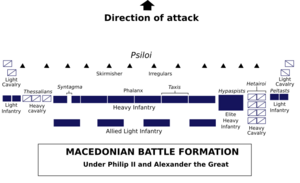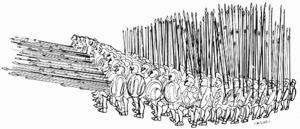Macedonian phalanx facts for kids
The Macedonian phalanx was a special way of arranging soldiers on the battlefield. It was created by King Philip II of Macedon. His son, Alexander the Great, used this powerful formation to conquer the huge Persian Empire.
This formation was made up of infantry (soldiers who fight on foot). They carried very long spears called sarissas. These spears were about 18 to 20 feet (5.5 to 6 meters) long! Soldiers needed both hands to hold a sarissa. They carried smaller shields slung over their left shoulder.
Contents
How the Phalanx Fought
The Macedonian phalanx was incredibly strong when attacked from the front. It was like a wall of spears that was very hard to break through. However, it was weak if enemies attacked from the sides or the back. This is where enemy cavalry (soldiers on horseback) could cause problems.
Because of this weakness, the phalanx needed protection. The Macedonian cavalry was very good at moving quickly and protecting the phalanx's sides.
Using the Phalanx in Battle
When a battle started, Alexander the Great often used the phalanx to "pin down" the enemy. This means the phalanx would keep the main enemy army busy and in one place. Meanwhile, Alexander's heavy cavalry would attack the enemy's horsemen. They would force the enemy cavalry to leave the battlefield.
After that, the cavalry would charge at weak spots in the enemy's lines or attack their sides. Then, the phalanx would move forward to attack the center of the enemy army.
Phalanx vs. Other Armies
Early Greek city-states often fought battles in narrow valleys. In these places, cavalry was not very important. Sometimes, there was little or no cavalry at all.
But during the Greco-Persian Wars, battles happened on more open land. Here, cavalry was a very strong force.
The Battle of Gaugamela
A great example of the phalanx in action is the Battle of Gaugamela. Alexander moved his army to the right. He wanted to stop the Persian army from surrounding his forces from both sides.
Darius, the Persian king, ordered his cavalry on his left side to attack the Greek cavalry. This was meant to stop Alexander's movement. But Alexander's special "Companion cavalry" then charged into the weakened center of the enemy army, right where Darius was. The phalanx followed close behind them. This helped Alexander win a major victory.
Images for kids
-
Fresco of an ancient Macedonian soldier holding a spear and wearing a cap. This is from the tomb of Agios Athanasios, Thessaloniki, Greece.
See also
 In Spanish: Falange macedonia para niños
In Spanish: Falange macedonia para niños




